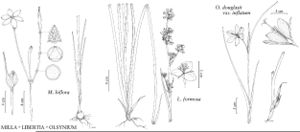Libertia formosa
Edinburgh New Philos. J. 15: 383. 1833.
IntroducedIllustrated
Revision as of 05:04, 30 July 2020 by imported>Volume Importer
Stems 60–125 cm. Leaf-blades linear, 15–45 cm × 5–15 mm. Rhipidia fewer than 10-flowered. Tepals white; outer suberect, flushed greenish or brownish abaxially, lanceolate, less than 10 mm; inner spreading, obovate, 12–18 mm; pedicel 6–12 mm. Capsules round to oblong, ca. 1 mm wide. Seeds ca. 25.
Phenology: Flowering spring.
Habitat: Disturbed, urban, coastal areas
Elevation: 0–50 m
Distribution
Introduced; Calif., South America (Chile)
Discussion
Libertia formosa is cultivated as an ornamental and is an uncommon naturalized escape in California.
Selected References
None.
Lower Taxa
None.
... more about "Libertia formosa"
extrorse +
not appressed +
parallel-veined +
ensiform +
petaloid +
filiform +
expanded +
thickened +
stigmatic +
cartilaginous;woody +
1 cm10 mm <br />0.01 m <br /> (?) +
monochasial +
small +
hard +
weak +
connate +
actinomorphic +
monochasial +
lasting +
aerial +
capsular +
woody;firm;cartilaginous +
Present +
rhipidiate +
spreading +
obovate +
true +
5mm;15mm +
distichous +
basal +
unifacial +
oriented +
suberect +
smaller +
axile +
inferior +
anatropous +
2;few +
not reaching +
membranous +
Edinburgh New Philos. J. +
1833 +
0-10-flowered +
large +
creeping +
light;dark-brown +
winged +
discoid +
angular +
globose;angular +
open +
closed +
green +
monochasial +
abaxial +
3-branched +
single +
Libertia formosa +
Libertia +
species +
white +
distinct +
spreading +
showy +
unequal +
arranged +
arcuate +
perennial +
unequal +
equal +
